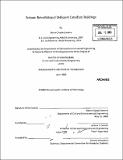Seismic retrofitting of deficient Canadian buildings
Author(s)
Gemme, Marie-Claude
DownloadFull printable version (16.84Mb)
Other Contributors
Massachusetts Institute of Technology. Dept. of Civil and Environmental Engineering.
Advisor
Jerome J. Connor.
Terms of use
Metadata
Show full item recordAbstract
Many developed countries such as Canada and the United States are facing a significant infrastructure crisis. Most of their facilities have been built with little consideration of seismic design and durability issues. As a result, these structures are vulnerable to earthquake loadings and are in urgent need of repair and retrofit. This thesis provides a literature review of the vulnerability of Canadian infrastructures built prior to the development of seismic design provisions in actual codes of practice and standards. It describes the performance of typical structures under earthquake loading, such as unreinforced masonry buildings, flat slab concrete buildings and steel frame buildings. It then presents the most common retrofitting strategies applicable to low-rise buildings commonly found in major Canadian cities. A case study assessing the performance of hybrid base isolation systems is then presented. The performance of passive and semi-active hybrid base isolation system is evaluated through the use of a SIMULINK computer model of a typical two-story concrete frame building. A significant reduction in interstory displacement is achieved using the passive system and further reduction in base displacement and base shear is accomplished using the semi-active system.
Description
Thesis (M. Eng.)--Massachusetts Institute of Technology, Dept. of Civil and Environmental Engineering, 2009. Includes bibliographical references (p. 74-77).
Date issued
2009Department
Massachusetts Institute of Technology. Department of Civil and Environmental EngineeringPublisher
Massachusetts Institute of Technology
Keywords
Civil and Environmental Engineering.